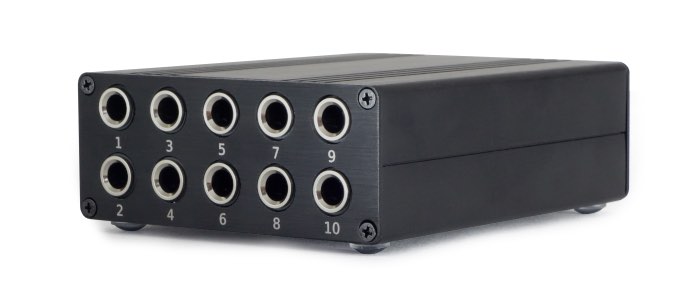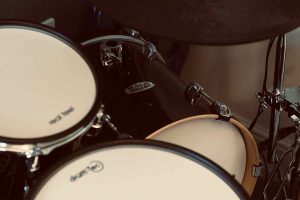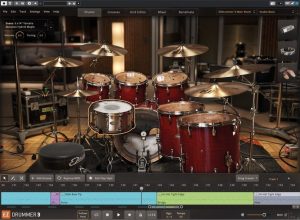The eDRUMin is a trigger interface popular with eDrummers for its low cost, compatibility with a vast range of pads, and suitability for triggering VSTs via a computer. Unfortunately, these interfaces have been in short supply for some time, and some models are still not in stock at the time of writing. If you had your eyes set on an eDRUMin trigger interface but need something immediately, then you might be looking for alternatives. Here, we look at what your options might be, either for a short-term stop-gap solution or as a longer-term alternative to the eDRUMin 10 or 4 input interfaces.
April 2023 update: After a long absence, the eDRUMin 10 is now back in stock, however the eDRUMin 4 is not. Check the Audiofront site for up to date stock information.
What is the Audiofront eDRUMin?
The eDRUMin is an eDrum trigger interface that converts signals from drum pads into MIDI and is available in two options, the base eDRUMin which has 4 trigger inputs, and the eDRUMin 10 with 10 inputs.

The eDRUMin promises robust triggering response, and support for both Roland and Yamaha pads, 3-zone triggering with just one cable on Roland and Yamaha cymbal pads, positional sensing with hot-spot suppression and support for Roland bell zones.

As a trigger interface, the eDRUMin does not feature a sound generator and is intended for sending MIDI signals to another device. That can be achieved via the MIDI out port or by using the built-in USB interface.
By connecting the eDRUMin to a computer and using the companion eDRUMin control software, you can configure the trigger settings and use the eDRUMin to trigger a VST drum library. The eDRUMin is a great option for triggering VSTs as a result, due to the lower cost than buying a fully-featured drum module and paying for a built-in sound generator that you won’t use.
Unfortunately, the two eDRUMin models, particularly the 10-input version, have been out of stock or hard to get hold of for some time. If you need an alternative now and can’t wait for the eDRUMin to become available again, then read on for some alternatives: other trigger interfaces, or used drum modules that sell for around the same price as the eDRUMin 10.
Trigger interface alternatives
A direct alternative for the eDRUMin is another trigger interface. Unfortunately, in 2023 there are few affordable alternatives around the same price. Some years ago the Alesis iO and DDrum DDTI Trigger Interface were available and offered 10 trigger inputs, just like the eDRUMin 10. These can still be had on the used market for around $100, though can be few and far between.
The main trigger interface alternatives are made by Roland. If you are looking for an eDRUMin 4 alternative and only need two trigger inputs, for example for a hybrid drumming setup, then the TM-1 is the most affordable option costing $199.
The Roland TM-2 is the next model up in the range, which adds onboard sound effects and an SD card slot to trigger your own samples. If you just want to use the TM-2 as a trigger to MIDI interface, then one advantage it has over the TM-1 is that each trigger input can be split into two for four single-zone trigger inputs in total. The TM-2 comes in at $299.
Finally, if 4 single-zone inputs are not enough, the next step up in the Roland range is the TM-6 Pro, featuring 6 trigger inputs including a dual-input that can be used with a hi-hat foot pedal controller.
The hi-hat support makes the TM-6 Pro the only one in the range to offer a proper eDrum experience. However, the 6 inputs aren’t really enough to power a full electronic kit. With a snare, kick and two toms, this only leaves enough for a hi-hat and a single crash cymbal. There is no dual-input socket to be able to use a three-zone ride cymbal.
The other issue is the price. The TM-6 Pro comes in at $899, which is $100 more than a standalone TD-17 module. For this reason, the TM-6 isn’t really suitable for a full eKit, and is best used for its main purpose to supplement an acoustic kit with additional electronic drum pads or add triggering to acoustic drums.
Pick up a used drum module
If you are looking for an alternative to the larger eDRUMin 10 with its 10 trigger inputs, then currently the only real solution is to buy a standard drum module. As the eDRUMin 10 would usually sell for $350, the only way to get a quality drum module for around the same price is to look at the used market.
Below, we’ve picked out three drum modules that come in below $350. That way, you could consider these to be stop-gap solutions ahead of the eDRUMin 10 becoming available again. And because these modules are each a few years old, there’s a good chance you could sell them for not much less than what you pay for them today.
Remember, you can also check out our guide on the best drum modules for VSTs if you want to explore other options.
Yamaha DTX 502
Target price: $230-270
If you need support for Yamaha pads, then you can’t go wrong with the DTX 502 which has 12 trigger inputs. This module was released in 2013 and features a USB interface for MIDI in and out, so you can hook it up to your VST drum library. Despite now being discontinued, drivers are still available from the Yamaha site. The latest release was in 2021 which added support for Apple Silicon (such as the M1 and M2 Macbooks). Windows 11 is also supported with the V3.1.4 Windows driver.
Be aware though that this module does not have hardware MIDI ports – MIDI is only supported over USB. This means you cannot connect another set of trigger inputs or another drum module directly to the DTX 502.
Roland TD-11
Target price: $200-250
Featuring 11 trigger inputs, the TD-11 launched in 2012 as part of Roland’s V-Compact series. As with the DTX 502, this module features a USB interface for connecting to your VST, plus is still supported with recent driver updates despite being over 10 years old. These kits were very popular in the day, making it easy to pick one up for around 2/3rds the price of a eDRUMin 10 as a stop-gap.
Check out our review of the Roland TD-11 for more details.
Roland TD-15
Target price: $300-350
The TD-15 is the bigger brother of the TD-11, launched at the same time but available only until 2015. VST drum users may prefer the TD-15 over the TD-11 due to the additional trigger input, bringing the total to 12. The TD-15 also has an independent headphone volume and a metronome that can be routed either to the headphone port or both headphone and master outputs.
While this module comes in much cheaper than the TD-15, it is generally more expensive than the TD-11, which may not be worthwhile if all you need is a temporary eDRUMin 10 stand-in. However, it could be worth considering as a longer term solution if you find one in good condition. The built-in audio interface is an upgrade over the eDRUMin, allowing you to connect your computer with a single cable and enjoy latency-free audio so you can play drums via your VST without issue.
Check out our TD-15 review for more information.
How to achieve Yamaha & Roland pad support
So far we have looked at alternatives from either Yamaha or Roland, but what if you’re looking for an eDRUMin for support for pads from both manufacturers?
Unfortunately full support for both Yamaha and Roland pads is quite rare, which is due to them being configured differently. The Pearl Mimic Pro is one module that supports both Roland and Yamaha pads, but it comes in at $2,549.
If you really need Yamaha and Roland pad support, one way to achieve it is to connect two modules together. There are a few ways this can be done:
Firstly, you could take the master audio out from one module and connect it to the mix-in on the other. This is the simplest way to get Yamaha and Roland support on one electronic kit. You’ll need to adjust the volume of each kit so they are balanced.
Secondly, if you have an older kit, you could connect the MIDI-out from one to the MIDI-in of the other. You would then need to set the MIDI notes from the first kit to unique values, and then assign those MIDI notes to instruments on the second module. However, this will limit you to drum modules that are around 15 years or older, as in around 2012, MIDI-in ports began to get removed from drum modules.
Finally, you could connect two modules to a computer via USB, and use your drum VST to assign the MIDI notes to specific sounds and instruments. You may also need to alter the MIDI notes on your modules to ensure they do not trigger the same instruments on your computer. To do this, you will also need to ensure your VST instrument supports more than one MIDI input device.
Of course, a final option is to consider selling your mismatched pads and consolidate your set-up to use pads from one manufacturer. This may be more cost-effective, especially if you only have a handful of pads that need to be swapped. You can then replace them with other used pads, or try some budget offerings such as the Lemon 18-inch ride or 15-inch china pads, which are compatible with Roland modules.
This article contains affiliate links. If you purchase a product through certain links on our site, we may earn a small affiliate commission. Learn more about our adverts and why you can trust eDrumHub here.




